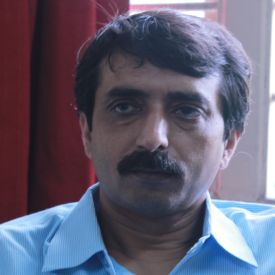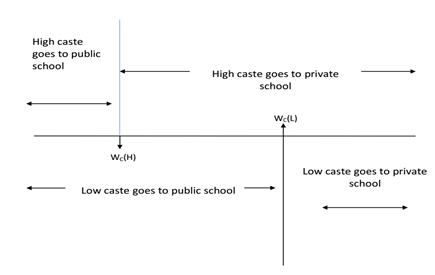Families' socioeconomic status impacts how parents make decisions regarding their children's education. Taking into account the interplay of caste and class, this paper finds that when families are too rich or too poor their caste identity does not affect their decisions about school choice. However, it is in the middle of the wealth distribution that caste identity matters most – students from disadvantaged castes whose parents are not as well connected in the labour market see lower returns to education.
In India, caste identity is the basis for affirmative action. It takes the form of providing quotas for disadvantaged caste groups – scheduled castes (SC), schedules tribes (ST) and other backward classes (OBC) – in educational institutions and government jobs. The strategy of affirmative action doubles as an anti-poverty programme as well, given that, on average, disadvantaged caste groups are poorer than the upper caste groups (more commonly referred to as general caste (GC)). But as a group, GC is quite heterogenous and caste based affirmative action strategies do not preclude the possibility of choosing a member of SC/ST groups as a beneficiary over a poorer member of GC.
Such a scenario raises a critical question: what should be the dimensions to identify a disadvantaged individual? Should affirmative action take into account one’s economic identity (class) or their social identity (caste)? In the recent past, India has seen intense political debates on this issue, which resulted in the creation of a 10% reservation for economically weaker sections (EWS) in government jobs and schools through the 103rd Constitutional Amendment Act of 2019. Despite the creation of EWS quota and its importance in Indian politics, we have not seen much work analysing the role of different identity dimensions in educational and labor market decision making.
In a recent study (Bhattacharya et al. 2021), we contribute to this literature by analysing how people's economic status and social standing interact to shape school choice decisions for their children.
Historical efforts to implement affirmative action
During colonial rule, the princely states of Kolhapur and Mysore introduced reservation for the backward castes in 1902 and 1921, respectively. The Government of India Act, 1935 enlisted the castes and tribes who are eligible for the benefits of reservation. These castes and tribes were mentioned in the schedules of the Act, and have since come to be known as scheduled castes and scheduled tribes in the common parlance. After independence, Article 46 of the constitution promised to protect the weaker section from social injustice and all forms of exploitation. The Indian Constitution, through its first amendment in 1951, made provisions for caste-based reservation in line with the Government of India Act, 1935.
After independence, there have been attempts to expand the affirmative action policies beyond SC/ST groups. In one such initial attempt, the first Backward Classes Commission was set up under the chairmanship of Kakasaheb Kelkar. The commission submitted its report in 1955, which called for the creation of job reservations for Socially and Educationally Backward Classes (SEBCs), but these recommendations were not implemented at that time. The second commission on the SEBCs was appointed under the chairmanship of B.P. Mandal. This commission submitted its report in 1980 and made several recommendations, including 27% reservation of jobs for the SEBCs in government services. These recommendations were finally implemented in 1990 by the National Front coalition government led by V.P. Singh. SEBCs other than SC/ST are now called the other backward classes.
Theoretical framework
The theoretical framework of our paper closely follows Galor and Zeira (1993). In their study, parents make human capital decision for their children and choose between an expensive (acquiring a skill) and an inexpensive (no skill acquisition) option. The expensive option, however, yields higher returns in the future.
In our study, parents decide how much to invest in a savings instrument and how much to put towards their children’s education. Regarding the school choice, they make two types of decisions – quality of the school and type of the school (public or private). In our model, we assume that private schools are expensive but yield a higher expected return in future. Public schools on the other hand are inexpensive, but the returns are also less. We also assume that, besides the quality of education one gets, labour market returns positively depend on one’s parental network, which in our model are proxied by their caste identities. In our model, caste identity is a binary of either high or low, with high caste parents having better labour market networks than their low caste counterparts. We further assume that the marginal return to quality is higher for private schools. Together, these two features in our model capture the central trade-off in decision making – investment in costly schooling can bring higher return for the children, but only if their parents are sufficiently better connected in the white collar job market.
Data
We have used Young Lives Survey data collected between 2002 and 2011 in the state of Andhra Pradesh to test our theoretical assertions. We use household survey data for the younger cohort of children (born between January 2001 and June 2002). The households included in the survey were surveyed three times: in 2002 (round one), 2006 (round two), and 2009 (round three).. In addition to household survey data, we use separate schooling data collected through visits to the schools and interviews with the principals of a randomly selected sub-sample of the cohort in 2011.
Empirical findings
Our model suggests that there will be a critical wealth level above which parents send their children to private schools. But this critical wealth level is different for different caste groups – in particular, the critical wealth for the high caste (Wc(H)) is lower than that for the low caste (Wc(L)). The decisions taken by high and low caste parents can be summarised by Figure 1.
Figure 1. Critical wealth levels of high and low castes
Essentially, this diagram suggests that caste identity does not matter for people belonging to the highest and the lowest wealth groups – rich parents (parents with wealth greater than a certain critical wealth (Wc(L) in the figure) send their children to private schools and poor parents (parents with wealth less than Wc(H))send their children to public schools irrespective of their caste. It is only the middle-income group parents (whose wealth level lie between the two critical wealth levels) for whom the caste identity matters in the choice of school type. Parents in this group have the wealth to send their kids to private schools, but the return the children belonging to disadvantaged castes get after going to the labor market does not justify the decision to spend money on private schooling. In our empirical section, we regress the school type variable over the wealth and caste of parents, along with other household variables (such as parental education, household size and regional location of the household), controlling for school choice. We also control for students’ ability, captured by scores on cognitive tests. Dividing the wealth groups into five quintiles, we find that among the richest and poorest (fifth and first quintile) caste identity does not have any impact on school choice. But in the intermediate quintiles (second, third and fourth) upper caste parents are more likely to choose private schools. Our results are robust to alternative caste and wealth categorisations.
Conclusion
Our analysis sheds light on the contentious issue of caste and class in the context of school choice decisions. We provide an analytical framework and empirical evidence which supports the hypothesis that caste identity matters in this context for middle-class households, but not for rich and poor households.
This finding might provide a clue for future reforms in the Right to Education (RTE) Act. In some states, RTE allows quotas for all SCs and STs in private schools without consideration of their wealth status (Srivastava and Noronha 2014). Our analysis suggests that, under RTE, there should be reservation for SC/ST students in private schools only if they come from middle-income households, while quotas should be provided for students from low-income households irrespective of their caste identities. The latter recommendation is consistent with the current provision of RTE, where parents below the poverty line, irrespective of their caste, may avail RTE quotas. However, caution is warranted while applying our results into policy making. Our empirical exercise illustrates a theoretical prediction, using a rather ad-hoc definition of the middle wealth group. Defining the middle class for the policy purpose would require more rigorous research using national level data.
Further Reading
- Bhattacharya, Sukanta, Aparajita Dasgupta, Kumarjit Mandal and Anirban Mukherjee (2021), "Class or caste? A study on the role of caste and wealth status in school choice decision", Review of Development Economics, 25(1), 255-276.
- Galor, Oded and Joseph Zeira (1993), "Income Distribution and Macroeconomics", Review of Economic Studies, 60(1): 35-52.
- Srivastava, Prachi and Claire Noronha (2014), "Insitutional Framing of the Right the Education Act: Contestation, Controversy and Concessions", Economic and Political Weekly, 49(18): 51-58.




 03 July, 2023
03 July, 2023 








Comments will be held for moderation. Your contact information will not be made public.